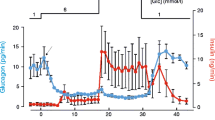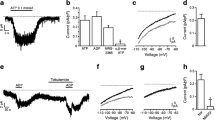Summary
The single-channel current recording technique has been used to study the effects of diazoxide, tolbutamide and ATP, separately and combined, on the gating of nucleotide-regulated K+ channels in the insulin-secreting cell line RINm5F. The effects of diazoxide, tolbutamide and ATP4− were studied at the intracellular membrane surface, using, the open-cell membrane patch configuration. Alone diazoxide was found only inconsistently to evoke channel stimulation, 57% of all applications of the drug (72 times in 48 separate patches) having no effect at concentrations between 0.02 and 0.4mm. In the presence of ATP, however, diazoxide consistently evoked channel activation (seen 87 times in 49 patches, 95% of all applications). The interactions of diazoxide and ATP seemed competitive. Stimulation of channels by diazoxide in the presence of 1mm ATP was suppressed if the concentration of ATP was elevated to 2 or 5mm. In solutions in which Mg2+ had been chelated with EDTA, diazoxide failed to activate channels closed by 1mm ATP; however, this was not due to a direct effect on the channels caused by the absence of Mg2+, but could be explained by the enhanced ATP4− concentration after Mg2+ removal. When the total ATP concentration was lowered to give the same [ATP4−] in the absence of Mg2+ to that present in the control experiments, diazoxide was able to evoke full activation. Channel inhibition evoked by tolbutamide, 0.01 to 1.0mm, did not require the presence of either ATP or Mg2+. In the presence of ATP tolbutamide further reduced the number of channel openings. Diazoxide was able to compete with tolbutamide for control of channel activity, an effect that was augmented by the presence of ATP. In the presence of 0.1mm tolbutamide, diazoxide was unable to stimulate channel openings; however, if the dose of tolbutamide was lowered or ATP made available to the inside of the membrane, channel stimulation occurred.
Similar content being viewed by others
References
Aschcroft, F.M., Kakei, M. 1987. Effects of internal Mg2+ on ATP-sensitive K-channels in isolated rat pancreatic B-cells.J. Physiol. (London) (in press) (Abstr.)
Cockroft, S., Gomperts, D. 1980. The ATP4− receptor of rat mast cells.Biochem. J. 188:789–798
Cook, D.L., Hales, C.N. 1984. Intracellular ATP directly blocks K+ channels in pancreatic B-cells.Nature (London) 311:271–273
Dahlquist, R., Diamant, B. 1974. Interaction of ATP and calcium on the rat mast cell: Effect on histamine release.Acta Pharmacol. Toxicol. 34:368–384
Dunne, M.J., Findlay, I., Petersen, O.H., Wollheim, C.B. 1986. ATP-sensitive K+ channels in an insulin secreting cell-line are inhibited byd-glyceraldehyde and activated by membrane permeabilization.J. Membrane Biol. 93:271–279
Dunne, M.J., Petersen, O.H. 1986a. Intracellular ADP activates K+ channels that are inhibited by ATP in an insulin-secreting cell-line.FEBS Lett. 208:59–62
Dunne, M.J., Petersen, O.H. 1986b. GTP and GDP activation of K+ channels that can be inhibited by ATP.Pfluegers Arch. 407:564–565
Findlay, I. 1987. The effects of magnesium upon the ATP-sensitive K+ channel in an insulin-secreting cell line.J. Physiol. (London) (in press)
Findlay, I., Dunne, M.J. 1986. ATP maintains ATP-inhibited K+ channels in an operational state.Pfluegers Arch. 407:238–240
Findlay, I., Dunne, M.J., Petersen, O.H. 1985a. High-conductance K+ channel in pancreatic islet cells can be activated and inactivated by internal calcium.J. Membrane Biol. 83:169–175
Findlay, I., Dunne, M.J., Petersen, O.H. 1985b. ATP-sensitive inward rectifier and voltage-and calcium-activated K+ channels in cultured pancreatic islet cells.J. Membrane Biol. 88:165–172
Halban, P.A., Praz, G.A., Wollheim C.B. 1983. Abnormal glucose metabolism accompanies failure of glucose to stimulate insulin release from a pancreatic cell line (RINm5F).Biochem. J. 212:439–443
Hamill, O.P., Marty, A., Neher, E., Sakmann, B., Sigworth, F.J. 1981. Improved patch-clamp techniques for high resolution current recordings from cells and cell-free membrane patches.Pfluegers Arch. 391:85–100
Henquin, J.C., Charles, S., Nenquin, M., Mathat, F., Tamagawa, T. 1982. Diazoxide and D600 inhibition of insulin release. Distinct mechanisms explain the specificity for different stimuli.Diabetes 31:776–783
Henquin, J.C., Meissner, H.P. 1982. Opposite effects of tolbutamide and diazoxide on86Rb+ fluxes and membrane potential in mouse pancreatic B-cells.Biochem. Pharmacol. 31:1407–1415
Hess, P., Lansman, J.B., Tsien, R.W. 1984. Different modes of Ca channel gating behaviour favoured by dihydropyridine Ca agonists and antagonistis.Nature (London) 311:538–544
Kakei, M., Kelly, R.P., Ashcroft, S.J.M., Ashcroft, F.M. 1986. The ATP-sensitivity of K+-channels in rat pancreatic B-cells is modulated by ADP.FEBS Lett. 208:63–66
Maruyama, Y., Petersen, O.H. 1984. Single calcium-dependent cation channels in mouse pancreatic acinar cells.J. membrane Biol. 81:83–87
Matthews, E.K. 1985. Electrophysiology of pancreatic islet B-cells.In: The Electrophysiology of the Secretory Cell. A.M. Poisner and J.M. Trifaro, editors. pp. 93–112. Elsevier Amsterdam
Misler, S., Falke, L.C., Gillis, K., McDaniel, M.L. 1986. A metabolite regulated potassium channel in rat pancreatic B-cells.Proc. Natl. Acad. Sci. USA 83:7119–7123
Noma, A. 1983. ATP-regulated K+-channels in cardiac muscle.Nature (London) 305:147–148
Ohno-Shosaku, T., Zunkler, B.J., Trube, G. 1987. Dual effects of ATP on K+ currents of mouse pancreatic B-cells.Pfluegers Arch. 408:133–138
Petersen, O.H., Findlay, I. 1987. Electrophysiology of the pancreas.Physiol. Rev. 67:1054–1116
Petersen, O.H., Findlay, I., Suzuki, K., Dunne, M.J. 1986. Messenger-mediated control of potassium channels in secretory cells.J. Exp. Biol. 124:33–52
Praz, G.A., Halban, P.A., Wollheim, C.B., Blondel, B., Strauss, A.J., Renold, A.E. 1983. Regulation of immunoreactive-insulin release from a rat cell line RINm5F.Biochem. J. 210:345–352
Ribalet, B., Ciani, S. 1987. Regulation by cell metabolism and adenosine nucleotides of a K channel in insulin secreting B-cells (RINm5F).Proc. Natl. Acad. Sci. USA 84:1721–1725
Rorsman, P., Trube, G. 1985. Glucose-dependent K+ channels in pancreatic B-cells are regulated by intracellular ATP.Pfluegers Arch. 405:305–309
Squire, L.G., Petersen, O.H. 1987. Modulation of Ca2+-and voltage-activated K+-channels by internal Mg2+ in salivary acinar cells.Biochim. Biophys. Acta 899:171–175
Steinberg, T.M., Silverstein, S.C. 1987. Extracellular ATP4− promotes cation fluxes in the J774 mouse macrophage cell-line.J. Biol. Chem. 262:3118–3122
Sturgess, N., Ashford, M.L.J., Cook, D.L., Hales, C.N. 1985. The sulphonylurea receptor may be an ATP-sensitive potassium channel.Lancet 8453:474–475
Trube, G., Rorsman, P., Ohno-Shosaku, T. 1986. Opposite effects of tolbutamide and diazoxide on the ATP-dependent K+-channel in mouse pancreatic B-cells.Pfluegers Arch. 407:493–499
Yellen, G. 1982. Single Ca2+-activated non-selective cation channel in neuroblastoma.Nature (London) 296:357–359
Author information
Authors and Affiliations
Rights and permissions
About this article
Cite this article
Dunne, M.J., Illot, M.C. & Petersen, O.H. Interaction of diazoxide, tolbutamide and ATP4− on nucleotide-dependent K+ channels in an insulin-secreting cell line. J. Membrain Biol. 99, 215–224 (1987). https://doi.org/10.1007/BF01995702
Received:
Revised:
Issue Date:
DOI: https://doi.org/10.1007/BF01995702




